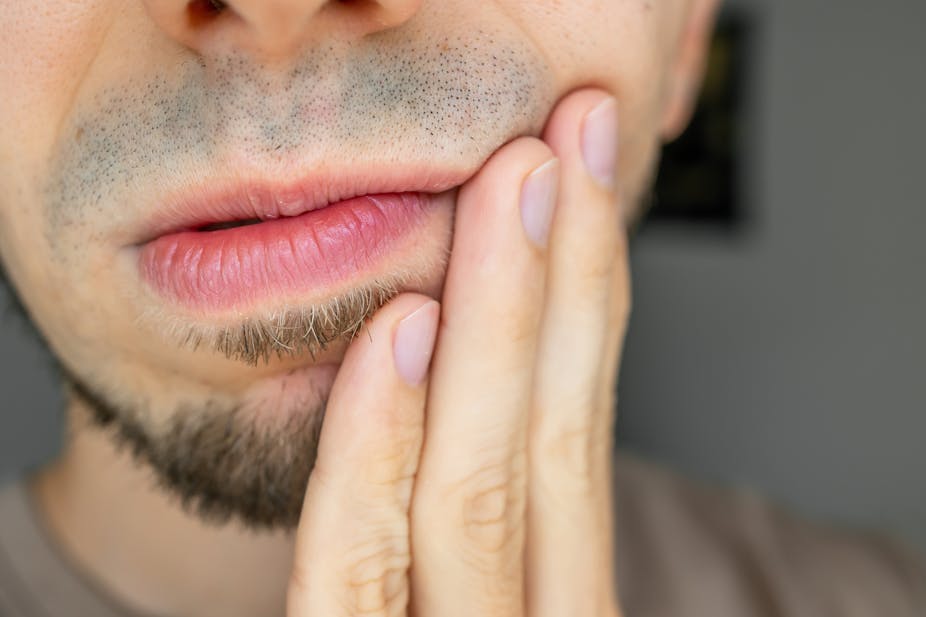The internet never ceases to amaze when it comes to the bizarre health crazes people are willing to try. One of the latest social media trends is “bone smashing” – and it’s every bit as insane as it sounds.
This involves subjecting your face to blunt force trauma in the hopes of permanently improving the way you look. The suggestion is that by using a hammer, rolling pin, bottle – basically whatever hard object you can find – and repeatedly driving it into the bony architecture of your face, you’ll alter your appearance.
It should go without saying, but just in case: don’t do it. Bone smashing will not permanently change your facial structure – but it may lead to other permanent harms, including tooth loss and blindness.
The ‘science’ behind the trend
Bone is a living tissue and is constantly rejuvenating itself in a tightly regulated process known as “remodelling”. In fact, your entire bone structure is completely replaced over the course of a decade. Remodelling ensures we only ever carry around as much bone as needed to support and protect our tissues, and adapts the architecture of our bones according to our movement requirements.
Certain stimuli can also change our bones. For example exercise – which places a “load” (external force) on our bones – ensures bone maintains its shape and strength. Without this stimulus, bone will begin breaking itself down to avoid carrying around anything we aren’t using.
Many videos promoting the use of bone smashing misinterpret a theory called Wolff’s law, which recognises that bones adapt to the stresses placed on them – and that over time, when a load is placed repeatedly on a particular bone, it will change it. For example, college athletes participating in sports like basketball, tennis and track have stronger bones in their dominant arm, compared to their non-dominant one due to the repeated stresses placed upon it.
But the key here is understanding that these bones only change as a result of the muscles surrounding them. When muscles pull against the attached bone, it helps stimulate growth. So while the bones in the face would indeed conform to Wolff’s law, it wouldn’t happen as a result of hitting these bones repeatedly.
And, if this were possible, we’d see these changes in professional sports people who take repeated blows to their face and skull. But in reality, most of the physical changes seen in such athletes are because of scar tissue or incorrectly healed fractures.
There’s no evidence that repeated blows to the face alter bone structure in humans. Although research shows it may lead to changes in rats, their bone structure and biomechanics are vastly different to humans. Not to mention, the animals in this study developed traumatic brain injuries as a result of these repeated blows.
Professional bone breaking
Repeated blows to the face can also cause fractures, since these bones are quite weak.

While it’s true numerous cosmetic surgeries require bones to be broken, this is only done when absolutely necessary – and performed in a specific place on the body. The process of breaking or shaving a bone to alter its shape is called an osteotomy, and is sometimes done during a rhinoplasty (a nose job) or a genioplasty (jawline surgery).
Although an osteotomy may change a person’s appearance and the alignment of certain bones, it can also change the way that bone functions. And, even when these surgeries are done by professionals, the recovery is lengthy – and the outcome may not be exactly what a patient wants. Not to mention, osteotomies also come with risk of complications such as nerve damage.
The bone that’s subsequently laid down to repair a fracture (known as “woven bone”) is also inferior in terms of both quality and structure. So while a typical fracture may take 6-8 weeks to heal as the woven bone connects the broken ends, it takes anywhere from a few months to years to get back to the original structure and quality of what was there originally.
Severe health risks
Many who may have tried the bone smashing trend have done so in order to alter the bone structure of the cheek bones (known as the zygomatic bones) or the jawbone (the mandible).
The zygomatic bone in each cheek facilitates facial expressions and protects the eyes. The mandible helps us chew, speak and gives the bottom of the face its shape. These structures are optimised for these functions, so hitting either of them with something heavy will likely only damage the bones. And, since our skull isn’t designed to take repeated heavy hits, bone smashing could lead to traumatic brain injuries, such as concussions.
Damage to the cheekbones will probably lead to bruising and swelling, which may in turn damage the eyes, as well as the nerves in the face – potentially leading to facial paralysis.
There are equal risks with damage to the mandible. A major blood vessel runs behind it, bringing blood to important parts of the face and head, including the teeth, parts of the ear and the brain linings. Significant damage to the mandible can tear this artery. Because of its position, it can be hard to see damage and stop bleeding into the surrounding tissues. This could lead to death – though it’s more likely to cause tooth damage or loss and nerve damage, which may lead to loss of sensation or function.
Even if this trend were able to give you your desired facial changes, you’d have to continue “bone smashing” for the rest of your life – as once you stop, the bone will revert back to its most efficient structure.
If you do want to change your face’s appearance, please consult a professional.


